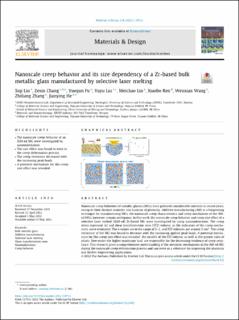| dc.contributor.author | Liu, Siqi | |
| dc.contributor.author | Chang, Zexin | |
| dc.contributor.author | Fu, Yuequn | |
| dc.contributor.author | liu, yuyu | |
| dc.contributor.author | Lin, Meichao | |
| dc.contributor.author | Ren, Xiaobo | |
| dc.contributor.author | Wang, Wenxian | |
| dc.contributor.author | Zhang, Zhiliang | |
| dc.contributor.author | He, Jianying | |
| dc.date.accessioned | 2022-05-30T12:40:57Z | |
| dc.date.available | 2022-05-30T12:40:57Z | |
| dc.date.created | 2022-05-03T15:47:30Z | |
| dc.date.issued | 2022 | |
| dc.identifier.citation | Materials & Design, 2022, 218, 1-10 | en_US |
| dc.identifier.issn | 0264-1275 | |
| dc.identifier.uri | https://hdl.handle.net/11250/2996866 | |
| dc.description.abstract | Nanoscale creep behaviors of metallic glasses (MGs) have gathered considerable interests in recent years, owing to their distinct atomistic mechanisms of plasticity. Additive manufacturing (AM) is a burgeoning technique for manufacturing MGs, the nanoscale creep characteristics and creep mechanism of the AM-ed MGs, however, remain ambiguous. In this work, the nanoscale creep behavior and creep size effect of a selective laser melted (SLM-ed) Zr-based MG were investigated by using nanoindentation. In an effort to gain more insight into the creep behaviors, the creep compliance and creep retardation spectra were extracted. The creep stress exponent (n) and shear transformation zone (STZ) volume, as the indicators of the creep mechanism, were estimated. The values of n are in the range of 2-3, and STZ volumes are around 2 nm3. The creep resistance of the MG was found to decrease with the increasing applied peak loads. A potential mechanism for this creep size effect was revealed: the smaller of the STZ volume, as well as the greater ratio of plastic flow under the higher maximum load, are responsible for the decreasing tendency of creep resistance. This research gives a comprehensive understanding of the atomistic mechanisms in the AM-ed MG during the nanoscale creep deformation process and can serve as a reference for improving the plasticity and further engineering applications. | en_US |
| dc.language.iso | eng | en_US |
| dc.publisher | Elsevier | en_US |
| dc.rights | Navngivelse 4.0 Internasjonal | * |
| dc.rights.uri | http://creativecommons.org/licenses/by/4.0/deed.no | * |
| dc.subject | Creep behavior | en_US |
| dc.subject | Nanoindentation | en_US |
| dc.subject | Shear transformation zone | en_US |
| dc.subject | Selective laser melting | en_US |
| dc.subject | Additive manufacturing | en_US |
| dc.subject | Bulk metallic glass | en_US |
| dc.title | Nanoscale creep behavior and its size dependency of a Zr-based bulk metallic glass manufactured by selective laser melting | en_US |
| dc.title.alternative | Nanoscale creep behavior and its size dependency of a Zr-based bulk metallic glass manufactured by selective laser melting | en_US |
| dc.type | Peer reviewed | en_US |
| dc.type | Journal article | en_US |
| dc.description.version | publishedVersion | en_US |
| dc.rights.holder | Copyright: 2022 The Authors. Published by Elsevier Ltd. | en_US |
| dc.source.pagenumber | 10 | en_US |
| dc.source.volume | 218 | en_US |
| dc.source.journal | Materials & design | en_US |
| dc.identifier.doi | 10.1016/j.matdes.2022.110723 | |
| dc.identifier.cristin | 2021117 | |
| dc.relation.project | Norges forskningsråd: 251068 | en_US |
| dc.relation.project | Norges forskningsråd: 295864 | en_US |
| dc.source.articlenumber | 110723 | en_US |
| cristin.ispublished | true | |
| cristin.fulltext | postprint | |
| cristin.fulltext | original | |
| cristin.qualitycode | 1 | |

